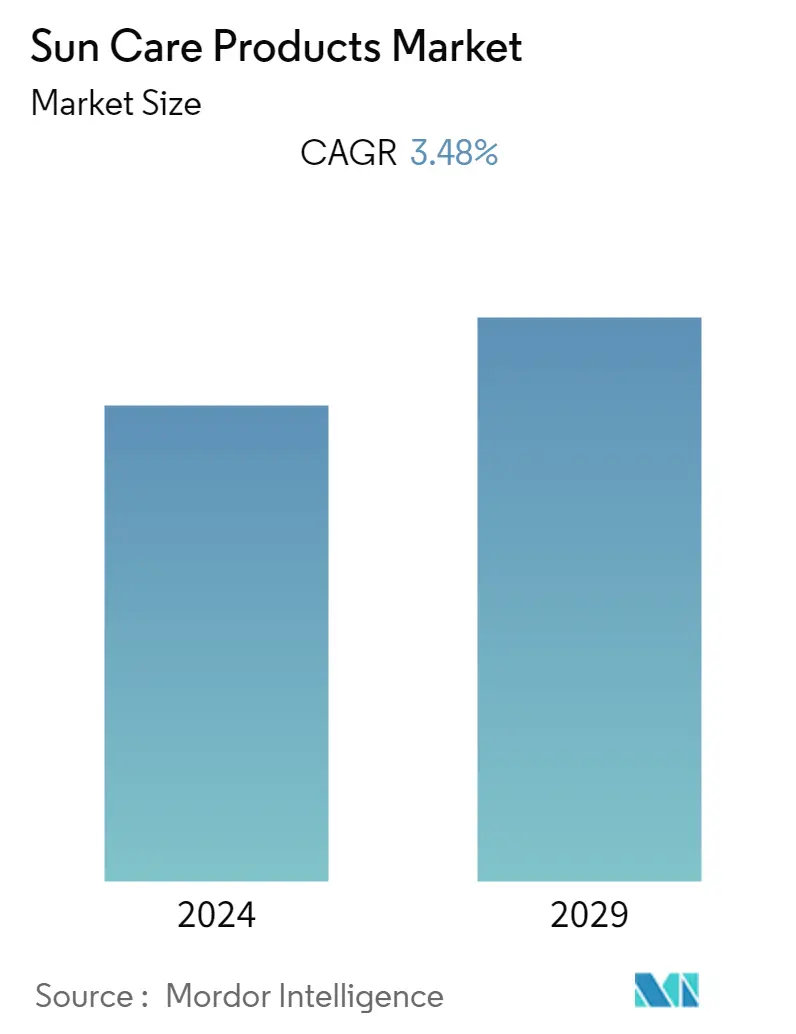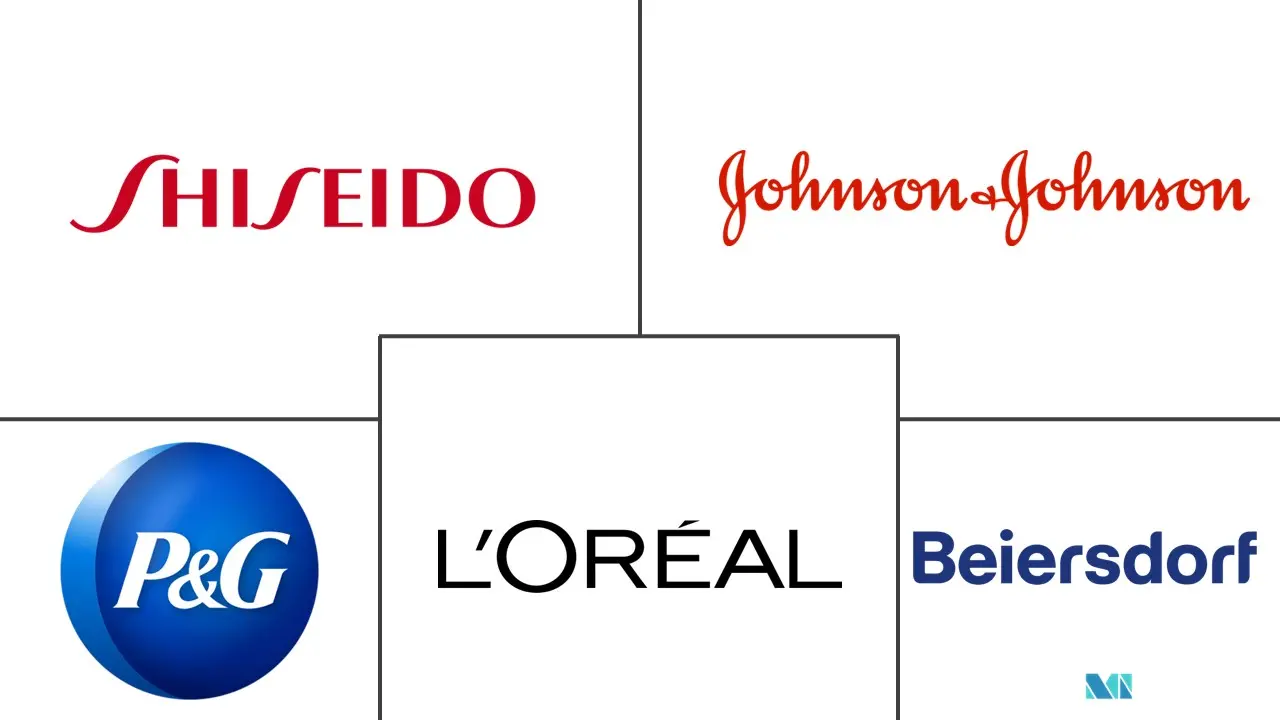Market Size of Sun Care Products Industry

| Study Period | 2019 - 2029 |
| Base Year For Estimation | 2023 |
| CAGR | 3.48 % |
| Fastest Growing Market | Middle East and Africa |
| Largest Market | Europe |
| Market Concentration | Low |
Major Players
*Disclaimer: Major Players sorted in no particular order |
Sun Care Products Market Analysis
The sun care products market is projected to witness a CAGR of 3.48% in the upcoming five years.
The market is anticipated to be one of the fastest-growing segments within the personal care industry, driven by the rise in consumer awareness related to skin cancer and aging associated with exposure to UV rays. The demand for self-tanning products is expected to surge in the foreseeable future, and most of the need is likely to be concentrated across North America and Europe.
Consumers will likely look for one-stop solutions across cosmetic brands in the coming years. Therefore, most sun care products available in the market are likely to be infused with a combination of compounds having anti-aging properties and intensive moisturizing solutions. For instance, in February 2022, the skincare brand La Roche-Posay introduced Anthelios UV Correct SPF 70 Daily Anti-Aging Face Sunscreen. It is formulated with Cellox-B3 Shield technology to protect the skin from signs of sun damage. It is formulated with an oxybenzone and octinoxate-free formula that blends on all skin tones and stimulates collagen production.
Furthermore, the growing demand for organic suncare products is expected to provide opportunities for market players in the coming years. These products are made of natural ingredients and are derived from plants. Thus, brands are now offering paraben-free suncare products to satisfy the growing demand for natural products in the market due to rising awareness about the side effects of chemicals used in suncare products.
Sun Care Products Industry Segmentation
Sun care products are in the form of cream lotion and spray applied to the skin to protect against the harmful effects of the sun's ultraviolet rays. The market is segmented by type (self-tanning products, after-sun products, and sun protection products), distribution channel (supermarkets/hypermarkets, specialty stores, online retail stores, and other distribution channels), and geography (North America, Europe, South America, Asia-Pacific, and Middle East and Africa). The report offers the market size and values (USD Million) during the forecasted years for the above segments.
| Type | |
| Self-tanning Products | |
| After-sun Products | |
| Sun Protection Products |
| Distribution Channel | |
| Supermarkets/Hypermarkets | |
| Specialty Stores | |
| Online Retail Store | |
| Other Distribution Channels |
| Geography | |||||||||
| |||||||||
| |||||||||
| |||||||||
| |||||||||
|
Sun Care Products Market Size Summary
The sun care products market is poised for significant growth, emerging as one of the fastest-expanding segments within the personal care industry. This growth is primarily fueled by increasing consumer awareness about the risks of skin cancer and aging due to UV exposure. The market is witnessing a rising demand for self-tanning products, particularly in North America and Europe, where consumers are seeking comprehensive solutions that combine sun protection with anti-aging and moisturizing benefits. The introduction of innovative products, such as La Roche-Posay's Anthelios UV Correct SPF 70, highlights the trend towards advanced formulations that offer both protection and skin enhancement. Additionally, the market is experiencing a shift towards organic and natural suncare products, driven by consumer preferences for paraben-free and chemical-free options, as awareness of the potential side effects of synthetic ingredients grows.
The global sun care products market is characterized by intense competition, with major players like L'Oréal, Beiersdorf, Shiseido, Procter & Gamble, and Johnson & Johnson leading the charge. These companies are expanding their product portfolios and distribution networks to capture a larger market share. The market's expansion is further supported by the increasing participation in outdoor activities, particularly in Western countries, where consumers with light-colored skin are more inclined to use sun care products. In the Middle East, companies are tapping into new markets by introducing products with natural and active ingredients, catering to the region's unique consumer preferences. The availability of products through extensive distribution channels and the influence of social media are also contributing to the market's growth, as consumers seek informed choices based on ingredient evaluations and expert recommendations.
Sun Care Products Market Size - Table of Contents
-
1. MARKET DYNAMICS
-
1.1 Market Drivers
-
1.2 Market Restraints
-
1.3 Porter's Five Forces Analysis
-
1.3.1 Threat of New Entrants
-
1.3.2 Bargaining Power of Buyers/Consumers
-
1.3.3 Bargaining Power of Suppliers
-
1.3.4 Threat of Substitute Products
-
1.3.5 Intensity of Competitive Rivalry
-
-
-
2. MARKET SEGMENTATION
-
2.1 Type
-
2.1.1 Self-tanning Products
-
2.1.2 After-sun Products
-
2.1.3 Sun Protection Products
-
-
2.2 Distribution Channel
-
2.2.1 Supermarkets/Hypermarkets
-
2.2.2 Specialty Stores
-
2.2.3 Online Retail Store
-
2.2.4 Other Distribution Channels
-
-
2.3 Geography
-
2.3.1 North America
-
2.3.1.1 United States
-
2.3.1.2 Canada
-
2.3.1.3 Mexico
-
2.3.1.4 Rest of North America
-
-
2.3.2 Europe
-
2.3.2.1 United Kingdom
-
2.3.2.2 Germany
-
2.3.2.3 Spain
-
2.3.2.4 France
-
2.3.2.5 Italy
-
2.3.2.6 Russia
-
2.3.2.7 Rest of Europe
-
-
2.3.3 Asia-Pacific
-
2.3.3.1 China
-
2.3.3.2 Japan
-
2.3.3.3 India
-
2.3.3.4 Australia
-
2.3.3.5 Rest of Asia-Pacific
-
-
2.3.4 South America
-
2.3.4.1 Brazil
-
2.3.4.2 Argentina
-
2.3.4.3 Rest of South America
-
-
2.3.5 Middle-East and Africa
-
2.3.5.1 South Africa
-
2.3.5.2 Saudi Arabia
-
2.3.5.3 Rest of Middle-East and Africa
-
-
-
Sun Care Products Market Size FAQs
What is the current Sun Care Products Market size?
The Sun Care Products Market is projected to register a CAGR of 3.48% during the forecast period (2024-2029)
Who are the key players in Sun Care Products Market?
Johnson & Johnson, Beiersdorf AG, Shiseido Company, Limited, Procter & Gamble Company and L'Oréal S.A. are the major companies operating in the Sun Care Products Market.

